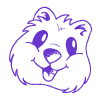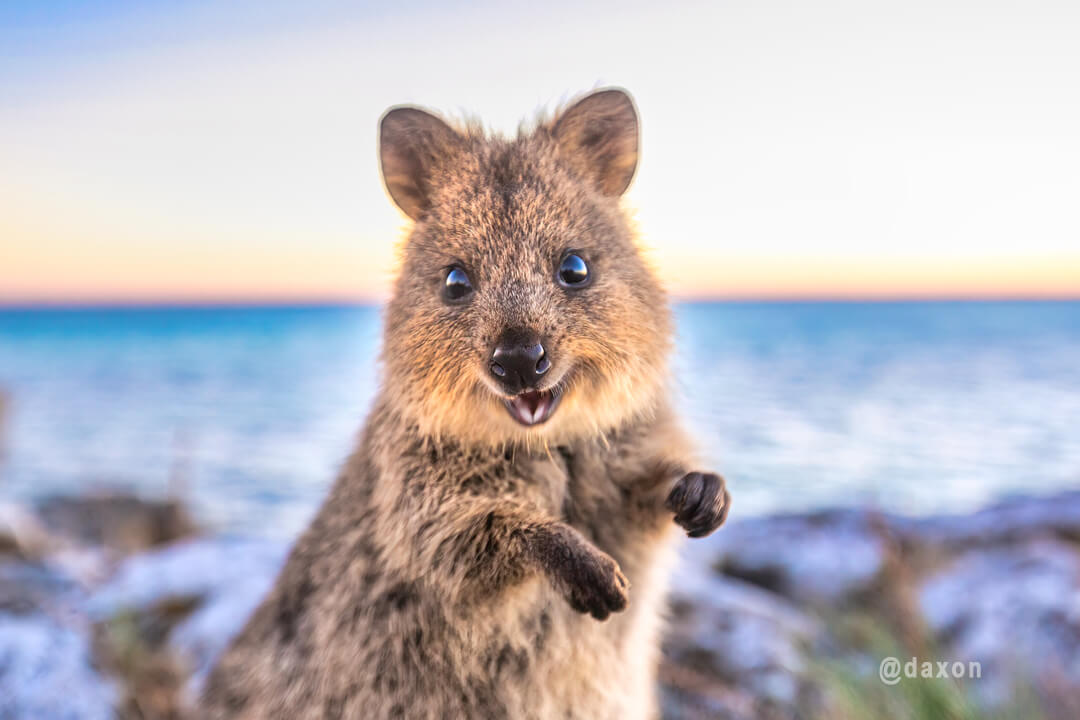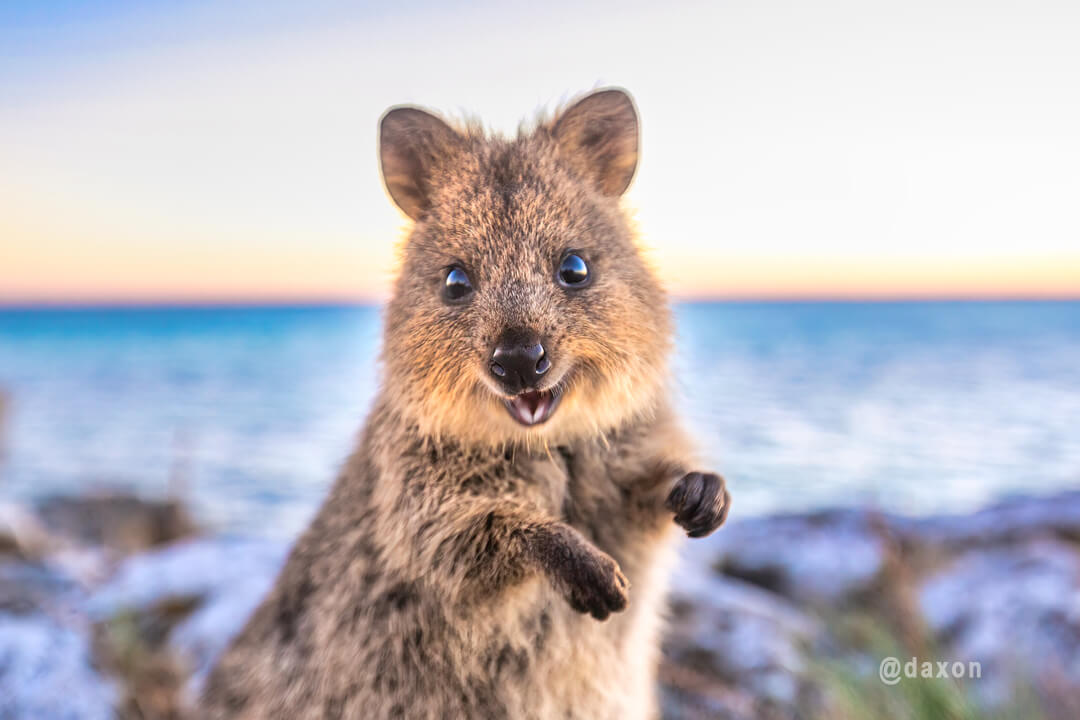Maybe you’ve just discovered what quokkas are or you already love them and want to learn everything about them. This is the right place.
Quokkas are so alluring because they’re perplexing! While looking at them, your brain tries to compare the quokkas to animals that you’ve seen before. But, quokkas are incomparable! It’s easy to wonder, wow, “how are they even real?”. The smiling face, the cuteness, it's all too good to be true.
But, it’s true. They exist,
Quokkas are small marsupials that belong to the kangaroo and wallaby family. Imagine a kangaroo-shaped animal that’s the size of a cat with a face of a teddy bear. The Quokka is known as "the happiest animal in the world" due to its perpetually smiling face and friendly demeanor.
These adorable creatures, which can grow up to 40 centimeters in length and weigh up to 2.5 kilograms, are most active at night and can be found in a variety of habitats including forests, woodlands, and coastal regions. They are herbivores, feeding on a wide range of plants and grasses.
Only found in a small area in Western Australia and the majority of quokkas live on Rottnest Island with a population of around 12,000. These unique, endangered animals have become a symbol for happiness.
Quokkas were first discovered by Europeans in 1658 by a Dutch ship, but the origin and history of quokkas is somewhat unclear. You can go visit them on Rottnest Island off the coast of Western Australia. We’ll be releasing a Visiting Quokka/Rottnest Island Travel Guide soon. Put the quokkas on your bucket list.
Quick Quokka Facts
-
Quokkas are small marsupials that belong to the kangaroo and wallaby family.
-
They’re native to Australia, and live in habitat that consists of forests, bush and grasslands, or coastal areas with dense vegetation and thick shrubs or trees that provide protection from predators such as foxes, dogs, cats and dingoes.
-
Quokkas are herbivores and eat plants, shrubs, fruit and grasses.
-
They have a lifespan of about 10 years.
-
Quokkas live in groups called mobs, which can be as large as 50 individuals. Mobs are usually made up of female quokkas and their young, but they also include adult males. When they’re not eating or sleeping, quokkas spend most of their time grooming each other.
-
They’re social animals and usually spend time together to make sure everyone is healthy. Quokkas are also very active, which means they need a lot of food to keep up their energy levels. They can eat up to two-thirds of their body weight in just one day!
-
Quokkas are nocturnal which means they usually sleep during the day and are active at night.
-
Quokkas are a vulnerable species. This means that they’re at risk of becoming extinct due to human activities or natural causes. The main threats to quokka survival are habitat loss, predation by cats and foxes, vehicle collisions and disease outbreaks.
-
They are territorial and have a home range. Quokkas are known to be curious and confident, which is why they are often found on beaches or near houses sniffing for food.
What do quokkas eat?
Quokkas are herbivores , which means they feed solely on plants. With a diet consisting of grass, leaves, shrubs, fig berries, stems. They’re not picky eaters, but when food is scare during the dry season, they will eat almost anything they can find in their environment.
Please, the most important thing, do not feed them any human food because our food is full of added preservatives and chemicals which will make quokkas sick. Ultimately causing them to die. Let the wild be wild.
Why are quokkas so cute?
If you've never seen a quokka before, you life is now about to change for the better. They’re a very rare and unique animal which is probably why. The quokka is a tiny animal that makes hearts melt all over the world. So powerful things come in small packages!
Now, why are quokkas so cute? The quokkas big smile is their most icon feature, brown fur, and big eyes. But perhaps most importantly—and what makes them so irresistibly cute—is their tiny hands and how they hold them. Also, they hop around like rabbits.
Their small size and rounded features give them a playful and innocent appearance that is hard not to love.
One of the most striking features of Quokkas is their perpetual smile, which is caused by the alignment of their mouth and their fur. This "smiling" expression has led to them being dubbed the "world's happiest animal."
Their cute appearance is further accentuated by their behavior. Quokkas are known to be curious and approachable, they have been known to come close to humans, and even approach them, This friendly behavior makes them even more endearing to those who encounter them.
Quokkas are also known to be active and playful, which adds to their cuteness. They are often seen climbing trees, foraging for food and interacting with other Quokkas, making them a pleasure to watch.
Where do quokkas live?
We know you want to meet them! Quokkas primarily live on Rottnest Island (a small island off the coast of Western Australia). They also live on the mainland as part of fragmented colonies in isolated forests in parts of south Western Australia.
If you want to see these adorable guys in person, you can visit Rottnest Island by taking a short ferry ride from Perth. A perfect day trip.
What's the origin and history of quokkas?
The origin and history of the quokka is unclear, but it was possibly first discovered in 1658 when the Dutchman, Volkersen, wrote that it resembled an Asian civet cat, but with brown hair.
In 1696 de Vlamingh described the quokka as "a kind of rat as big as a common cat". He named the Island 'Rotte nest' (meaning 'rat's nest') and the name of the Island was eventually adapted to 'Rottnest'
The quokka may have been introduced to Rottnest Island in the 1830s by British settlers from mainland Australia, but have become extremely venerable on mainland Australia due to introduction of predators like foxes and feral cats.
What's the conservation status of quokkas?
Quokkas are having a pretty tough time out there. We wish it wasn’t the case.
The conservation status of the quokka is vulnerable and endangered. The IUCN Red List considers it a vulnerable species, with a decreasing population trend that meets the threshold for "endangered" classification.
Quokkas are protected by law in Western Australia and are considered a vulnerable species, with their population declining due to habitat destruction and introduced predators. Efforts are being made to protect and conserve Quokkas in their natural habitat.
One major threat to the quokka's survival is predation by feral cats, dogs and foxes. Feral goats also compete with native herbivores for food particularly during droughts.
Quokkas have experienced drastic population declines across their range due to human activities such as coastal, urban development and land clearance for agriculture . Fragmented colonies are mainly due to road construction or again, clearing land for pasture and crops.
How can I get involved with helping quokkas?
If you love quokkas, there are a few organisations working to save quokkas.
- The Rottnest Foundation holds multiple tree planting events throughout the year. You can join as a member and help plant vegetation around the island and provide habitat for the quokkas.
- The Rottnest Island Authority manages the island where quokkas are located as well as other areas around Western Australia. They offer guided tours that showcase both indigenous and non-indigenous wildlife on Rottnest Island. You can apply to volunteer with them to spend time on Rottnest Island and help visitors.
Quokkas are truly unique and special animals that have captured the hearts of many with their adorable appearance and friendly personalities. It's important that we continue to protect and conserve these amazing creatures for future generations to enjoy.




3 comments
These guys should become the world leaders
sigma quokkas
Thank you so much.They are just so cute.
It’s happy to watch especially in these times